
All iLive content is medically reviewed or fact checked to ensure as much factual accuracy as possible.
We have strict sourcing guidelines and only link to reputable media sites, academic research institutions and, whenever possible, medically peer reviewed studies. Note that the numbers in parentheses ([1], [2], etc.) are clickable links to these studies.
If you feel that any of our content is inaccurate, out-of-date, or otherwise questionable, please select it and press Ctrl + Enter.
Treatment for tracheitis
Medical expert of the article
Last reviewed: 04.07.2025
As a rule, uncomplicated tracheitis is treated at home; inpatient treatment of tracheitis is used extremely rarely, in cases where the symptoms become threatening - attacks of suffocation, asthma, high temperature and other complications associated more with inflammation of the bronchi and lungs.
Tracheitis is not a serious, dangerous disease, but it should be taken seriously, as it can be fraught with complications - tracheobronchitis, bronchopneumonia. In addition, the disease can be quite protracted, especially when it becomes chronic, recurring. That is why the question of how to treat tracheitis worries many who have been diagnosed with this disease. It is treated in accordance with the form and severity of symptoms.
The viral form of the disease is treated without antibiotics, if the disease is caused by bacteria, antibacterial therapy is indispensable. Amoxicillin, clarithromycin, azithromycin are prescribed - the choice of drug, dose and regimen depend on the type of pathogen, the form and severity of the inflammatory process. The treatment of tracheitis includes many measures, rules, the observance of which is not difficult. Among the main recommendations, the following can be mentioned:
- The entire treatment process should be accompanied by drinking plenty of fluids. Warm herbal infusions, vitamin fruit drinks and teas, and still mineral water at room temperature are suitable as drinks.
- The room where the patient is located should be frequently ventilated and wet-cleaned. Air humidity is of great importance, especially in the case of a dry cough.
- Dry cough is treated with antitussives - sinekod, lazolvan, libexin and other drugs prescribed by the doctor.
- If the cough is unproductive, sputum is difficult to remove, the use of drugs that can liquefy and reduce the viscosity of secretions is indicated. This can be ambroxol, acetylcysteine and other drugs.
- If the disease is accompanied by a high temperature (above 37.5 degrees), treatment of tracheitis involves taking antipyretic drugs - paracetamol, ibuprofen.
- During the entire treatment process, it is necessary to carry out alkaline inhalations.
Drug treatment of tracheitis
Drug treatment of tracheitis is indicated only when the disease is provoked by a bacterial infection. When eliminating the root cause of the disease, broad-spectrum antibiotics are used, usually in aerosol form, less often in tablet form. As a rule, doctors try to prescribe antibacterial agents from the category of natural penicillins; if the disease is complicated by bronchitis, it is possible to prescribe the latest generation of semi-synthetic antibiotics.
The acute form of the disease, which occurs without complications and is caused by a virus, is treated with antitussives, antiviral and immunomodulatory drugs, and less often with antihistamines.
Effective drug treatment of tracheitis includes the use of aerosols, since this form of the drug is able to penetrate all areas of the trachea and bronchial tree. Inhalations using ultrasound devices and antiseptics are also effective. The most frequently prescribed drugs that have proven effective in the treatment of tracheitis are the following:
- Bioparox in aerosol form.
- Sinekod, which has a pronounced antitussive effect.
- Lazolvan, both in tablet form and in syrup form.
- Erespal, which has a broad spectrum of action, is an anti-inflammatory, antitussive and antihistamine drug.
- Berodual is an effective solution for inhalation through a nebulizer.
- Sumamed is a drug from the macrolide group that acts on all types of pathogens causing respiratory infections.
Drug treatment is used according to indications that exclude the use of other more gentle means, including traditional medicine recipes, as well as in complicated forms of the disease.
Medicines for tracheitis
Medicines for tracheitis are prescribed after a thorough medical examination, so self-medication, especially in the case of a child's illness, is unacceptable. If the disease develops due to a bacterial infection, then drugs of the penicillin group are prescribed. They are most often prescribed intramuscularly in the form of injections, 4-6 times a day, depending on the severity of the disease. Preference is given to the latest generation of drugs, the so-called protected penicillins, which have a wide spectrum of action. The most popular in this sense is Augmentin, which is also available in tablet form.
If the patient is intolerant to penicillin drugs, then the drugs for tracheitis are a group of cephalosporins or drugs from the macrolide group. These drugs can be prescribed both in tablet and injection form. Both cephalosporins and macrolides are convenient in that they most often need to be taken once, that is, once a day. Macrolides are especially effective in mycoplasma etiology. If the disease is accompanied by a viral complication, which is quite common, azithromycin is indicated, which is also taken once for 3-5 days. Azithromycin is considered an effective antiviral drug that is suitable for both children and pregnant women.
Medicines are prescribed with the utmost caution, thoughtfully, taking into account all the features of the course of the disease and the patient's condition.
Bioparox
Bioparox for tracheitis is considered one of the most effective aerosol agents containing the component - fusafungin. Fusafungin has a clearly expressed antibacterial effect, it also relieves inflammation and is active against staphylococcal infection. In addition, fusafungin, being a substance of fungal origin, effectively fights intracellular parasites - legionella and mycoplasma. Such a wide range of action, which Bioparox has for tracheitis, allows to stop almost all inflammatory processes in the respiratory system.
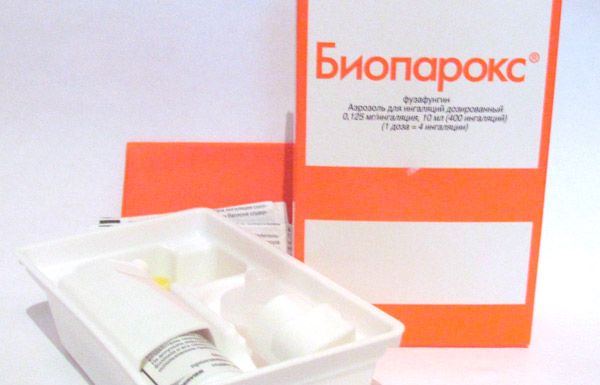
Aerosol spraying with Bioparox is indicated for 7-10 days, it is used every four hours for 4 inhalations. There is a treatment option for adult patients, when Bioparox is injected only nasally - two inhalations in each nostril four times a day. For children, inhalation sprays are alternated - from two to four inhalations into the mouth and from two to four inhalations nasally (1/2 in each nostril).
Bioparox is used strictly according to the scheme prescribed by the doctor. Even if relief occurs on the second or third day, the cough becomes less intense, the treatment should be continued until the prescribed time.
Sinekod
Sinekod is an effective antitussive drug that affects the cough center, suppressing it. In addition, Sinekod is prescribed for tracheitis when the disease is accompanied by inflammation of the bronchi, since the drug has a bronchodilator effect. The patient's breathing is noticeably easier, the blood is saturated with oxygen, the general condition improves.
The main active ingredient of the drug is butamirate, which is effective against unproductive cough. Sinekod is prescribed even to babies in the form of syrup or special drops, but the drug can only be used from the third month of the child's life. Sinekod is not prescribed to pregnant women and those who are breastfeeding.
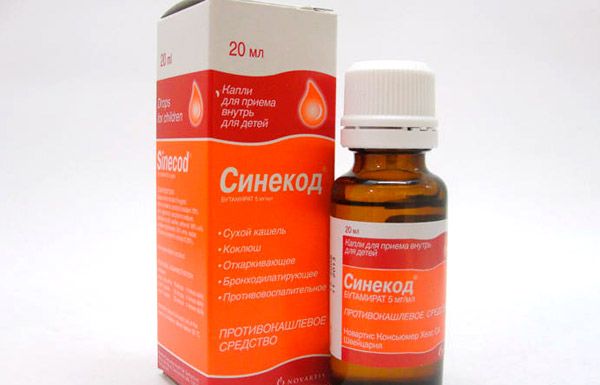
Sinekod may cause some side effects, such as diarrhea, hives, dizziness or vomiting. Of course, this can only happen in exceptional cases - these are the consequences of an overdose of the drug or self-medication.
The doses that are usually prescribed for treatment with Sinekod are as follows:
- Children from six months to one year (body weight up to 8 kg) – 8-10 drops four times a day.
- Children under three years of age (body weight up to 15 kg) – 12-15 drops four times a day.
- Children over three years old – 20 drops four times a day.
- Children from six to nine years old – 10 ml of syrup three times a day.
- Children from 9 to 15 years old – 15 ml of syrup three times a day.
- Adult patients – 15 ml of syrup three or four times a day.
- Tablet form for adults – 10 mg three times a day.
Sinekod for tracheitis is also suitable for treating diabetics, since both the drops and the syrup contain sorbitol instead of sugar. Sinekod is not prescribed to those who have been diagnosed with lactose intolerance, as well as to those patients who perform work that requires concentration.
Lazolvan
Lazolvan is prescribed as a stimulant of the motor properties of the respiratory system and as a secretolytic.
Lazolvan is effective in the treatment of tracheitis, pharyngitis, acute laryngitis, as well as acute bronchitis and pneumonia of unspecified etiology. The active component of Lazolvan is ambroxol.
Lazolvan for tracheitis is prescribed to both children and adults in the following dosage:
- Capsules - only for adults and children over 12 years old, one-time use, the duration of the course is determined by the doctor, but as a rule, Lazolvan is taken for at least five days.
- Tablet form. Adults - three times a day, one tablet during the first three days of illness, then the regimen is reduced - two tablets (one twice) for three days and half three times a day. Children from 6 to 12 years old are prescribed half a tablet three times a day.
- Lazolvan is effective in the form of syrup. Adults should take syrup AO10 ml three times a day, after three days 10 ml twice a day. Children under two years of age are prescribed syrup 2.5 ml twice a day, from two to five years - 2.5 ml three times a day, children from 5 to 12 years - five milliliters three times a day.
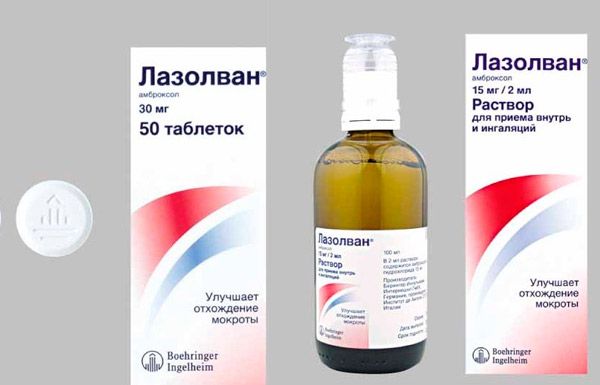
Lazolvan should not be combined with other cough medications, it is also contraindicated in the first trimester of pregnancy, if the woman is breastfeeding, and in case of gastric ulcer or duodenal ulcer.
Erespal
Erespal is prescribed for tracheitis when it is necessary not only to relieve the cough symptom, but also to relieve inflammation of the mucous membrane of the tracheal wall. Erespal is considered a multicomponent drug, as it has an antihistamine effect, prevents bronchial spasm, and is also an anti-inflammatory agent. Erespal is successfully used in the treatment of upper respiratory tract diseases in both adults and children. The drug blocks H1 histamine receptors, as well as adrenergic receptors, thereby relaxing the muscles of the bronchial tree, reducing the release of inflammatory mediators and reducing the amount of sputum. The drug is produced in a convenient form for use - in tablets and syrup.
Erespal is used for tracheitis in the following dosages:
- Older patients - one tablet twice or three times a day depending on symptoms
- Children under 14 years of age – syrup, calculation – 4 milligrams per kilogram of weight once a day before meals.
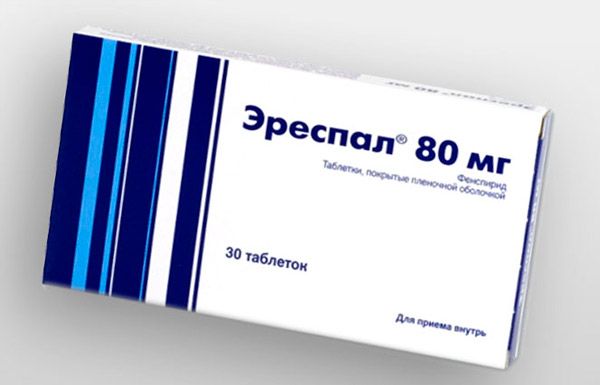
Erespal is most often prescribed in a course of 10 to 15 days, less often longer in case of recurrent chronic disease. Contraindications - hypersensitivity to fenspiride - the main active ingredient, the first trimester of pregnancy and breastfeeding.
Sumamed
Sumamed is prescribed for acute forms of the disease caused by a bacterial infection, or for chronic, recurrent disease accompanied by complications such as bronchitis, otitis and other inflammations.
Sumamed (azithromycin) belongs to the group of broad-spectrum macrolides, which are effective against all the main pathogens of infectious inflammation of the upper respiratory tract. It is believed that treatment with sumamed is also effective against the fairly common hemophilic bacillus, in addition, the drug has a long elimination period, which means that it can be taken once (once a day). Literally in three days, sumamed for tracheitis of an infectious nature, as well as for other bacterial infections, gives a tangible therapeutic result.
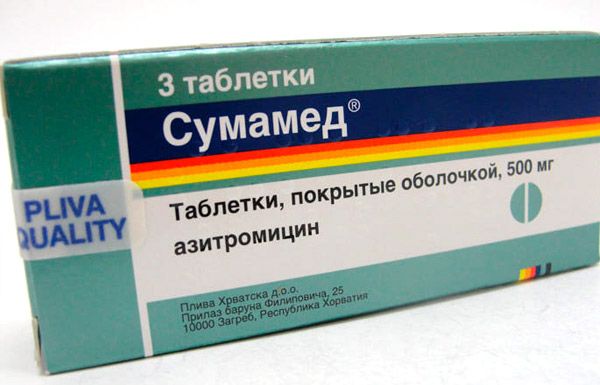
The drug is available in the form of a suspension, tablets and capsules. Sumamed for the treatment of tracheitis is most often prescribed in the form of powder for syrups or suspensions, which is very convenient in the treatment of the disease in young children.
Berodual
Berodual is a combination drug with a pronounced bronchodilator effect, which consists of ipratropium bromide and fenoterol hydrobromide.
Berodual is primarily an effective means for inhalations that prevent asthma attacks, expand the bronchi, relieve spasms, and normalize the formation of mucous secretions. The drug is produced in the form of a special canister or in the form of a solution for inhalation. The effect occurs within 10-15 minutes and lasts up to ten hours.
Berodual is used in the form of inhalations through a nebulizer in the following dosages:
- Children under six years of age – 10 drops per procedure, no more than three times a day.
- Children from 6 to 12 years old – 20 drops per procedure 3-4 times a day.
- Adult patients – 40 drops per procedure no more than 4 times a day.
To avoid complications (tachycardia and excessively active bronchial dilation), the drug is used starting with the lowest therapeutic dose. The specified amount of berodual is diluted in saline and used by inhalation using a special nebulizer.
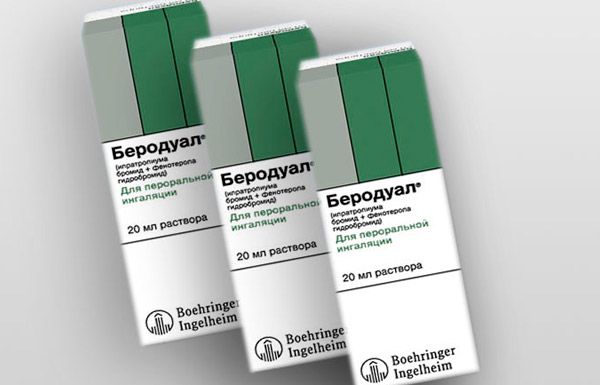
Berodual is not prescribed for tracheitis if the patient has cardiomyopathy, tachycardia, in the first and third trimesters of pregnancy, in case of intolerance to atropine drugs and in children under six years of age.
Antibiotics for tracheitis
Antibiotics for tracheitis are prescribed quite rarely, however, if the disease recurs and has an infectious, bacterial etiology, serious treatment is indispensable. For infectious diseases of the upper respiratory tract, the following antibiotics are prescribed:
- Penicillin group – Augmentin, Amoxicillin, Flemoxin Solutab, Ampicillin, Amoxiclav and other drugs in this category.
- The group of fluoroquinolones – Moximac, Avelox, Levofloxacin, which are prescribed in case of ineffectiveness of treatment with the penicillin group of drugs.
- Cephalosporin group – Zinacef, Zinnat, Axetine, Cefixime and other drugs in this category. The drugs are prescribed in case of a disease complicated by bronchitis or pneumonia with severe symptoms in the form of high temperature, unproductive cough, general weakness.
- The group of macrolides, most often prescribed for the infectious form of the disease. Most often prescribed is Sumamed (Azithromycin), which has an effective effect on most inflammatory pathogens and is taken once a day.
Antibiotics for tracheitis are not prescribed to children, elderly patients, and pregnant women in the first and third trimesters.
 [ 3 ]
[ 3 ]
Massage for tracheitis
In addition to medicinal treatments, there are additional methods that are very effective both for suppressing cough and for activating the immune system. Such methods include point massage for tracheitis. Acupuncture points should be known, since they are the main zones that activate the body's defenses in any other diseases. Massage is performed using pressure or vibrating non-stop movements. Like any other massage procedures, activation of biologically active points cannot be carried out with elevated body temperature, blood diseases and complicated pregnancy.
The massage is performed in the following active areas of the body:
- The point called the point of 100 diseases or hegu. It is located in the fleshy area between the index finger and the base of the thumb. It must be periodically massaged with rotational movements, it is quite painful, but the massage will be effective.
- The point under the seventh vertebra on the neck is dachzhuy. The massage is indicated by pressing, 10-15 times, with breaks.
- The point above the middle of the jugular notch, right in the center of the depression is the tiantu point. The massage is performed with gentle rotational movements for a minute with breaks.
- The point in the middle between the kneecap and the transverse line of the ankle joint is fenglong. It can be measured with three fingers of the hand to the side from the end (edge) of the tibia. The massage is performed both with rhythmic pressure and with rotational movements.
- The point, which is located in the center of the sixth intercostal space, vertically through the right or left nipple. The massage is performed by rhythmic pressure.
Massage for tracheitis is also performed using simple stroking movements directed from the center of the chest upwards, while rubbing with warming ointments. This massage is especially effective in treating small children. The movements should be soft, careful, in the form of circular spiral movements from the center of the chest upwards to the neck.
Treatment of tracheitis at home
Tracheitis is not considered a life-threatening disease, as a rule, treatment is carried out on an outpatient basis, at home. The viral form of the disease requires strict bed rest and maximum limitation of contacts with others. Such a regimen is dictated by the high contagiousness of viral diseases, firstly, the patient can get an additional infection, secondly, he can be a source of infection for relatives and friends.
Treatment of tracheitis at home involves following the following rules and recommendations:
- Bed rest for 5-7 days, possibly longer, it all depends on the severity of the disease.
- Drink plenty of fluids, often – teas, decoctions, fruit drinks. The more the patient drinks and the more actively the urinary system works, the faster the virus or bacterial infection is eliminated from the body.
- It is necessary for those who care for the patient to carry out regular wet cleaning in the room. Air humidity directly affects the nature of the cough, which is usually dry and frequent.
- Since attacks of debilitating cough most often haunt the patient at night, before going to bed you should take a dose of an antitussive (syrup, tablet). This can be Lazolvan, Sinekod or other drugs prescribed by the doctor.
- Regular inhalations, which should be done at least two, and preferably three times a day.
- If the patient does not have a fever, daily rubbing with warming ointments can be done, and mustard plasters can be applied an hour before bedtime.
Treating tracheitis at home means following all doctor's recommendations, even if the cough or temperature disappears a few days after the onset of the disease. Interrupting the therapeutic course is fraught with complications and relapse of the disease.
Inhalations for tracheitis
Inhalations for tracheitis are one of the most important means of relieving a debilitating cough and improving the general condition of the patient. All plants, pharmaceutical preparations containing phytoncides or volatile essential anti-inflammatory oils effectively act on both the cough center and the bronchi. The list of medicinal plants for inhalations includes eucalyptus, fir, juniper, pine and ginger. Inhalations can be carried out using special devices, or you can use traditional home methods - inhaling vapors over a saucepan with a healing decoction. Inhalations for children under three years old are carried out in this way: heat a saucepan with water and an essential plant, tightly close the windows and door in this room and breathe in the vapors together with the baby for at least 10 minutes. You can also use aroma lamps as mini-inhalations, more similar to aromatherapy. There is another rather popular and simple way to provide the necessary useful evaporations: drop some aroma oil (eucalyptus, fir, pine, spruce) on a damp cloth and hang the cloth near a warm radiator. The heat will cause the ether to evaporate and saturate the room with useful bactericidal components.
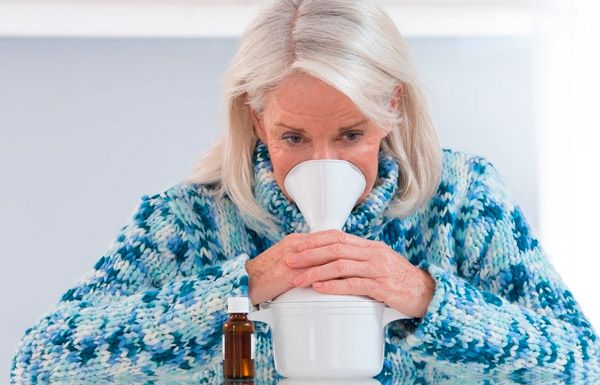
Inhalations with a steam inhaler are also effective. The mixture for it can be prepared as follows: add essential oil (3-5 drops) to hot water, add a teaspoon of soda and 2-3 drops of iodine (contraindicated for allergy sufferers). You should lean over the container with evaporating water, cover yourself with a towel and deeply inhale the vapors for at least 5 minutes.
Of course, inhalations are easier to do with industrial inhalers, of which there are a great many now. The easiest to use is a nebulizer, which will ensure reliable penetration of phytoncides into the respiratory tract.
Traditional treatment of tracheitis
Traditional treatment of tracheitis is really effective provided that the disease is relatively mild and has no complications requiring antibacterial therapy. Herbal remedies for bacterial or allergic variants of the disease are not able to replace basic therapy, this must be understood and taken into account.
Here are some recipes that folk remedies for tracheitis offer:
- The form of the disease that is not accompanied by a high temperature can be treated with mustard foot baths. A handful of dry mustard is poured into fairly hot water, stirred, and the feet are steamed for 10-15 minutes until the water becomes warm.
- Dry mustard can be sprinkled into cotton socks that are worn at night.
- Regular intake of green tea with raspberries and honey will help to cope with cough faster. For a glass of hot green tea - half a teaspoon of mashed raspberries and honey.
- Pour a liter of boiling water over dry viburnum berries (50 grams), boil for 5 minutes. Strain and drink hot.
- A compress on the chest from hot boiled (in the skin) potatoes. Boiled potatoes are mashed hot with the skin, put into a cloth napkin and placed on the middle of the chest until cool.
- Rubbing the chest with a mixture of honey and propolis in a 1:1 ratio is effective for dry coughs.
Traditional medicine should be reasonable, you should not use unverified recipes, given that many plant substances can cause allergies, in addition, not all herbs are indicated for dry cough.
 [ 8 ], [ 9 ], [ 10 ], [ 11 ], [ 12 ]
[ 8 ], [ 9 ], [ 10 ], [ 11 ], [ 12 ]
Treatment of tracheitis with a nebulizer
Nebula is a Latin word meaning a cloud, a vapor accumulation, a fog. This is what a special device used for inhalations was called. Tracheitis treatment with a nebulizer is a modern inhalation, convenient and really effective, which is strikingly different from the so-called home methods, when a person leans over a steaming saucepan.
The nebulizer was created so that not a single evaporated healing droplet would pass by the respiratory tract of a sick person. Modern treatment of tracheitis with a nebulizer is one of the main methods of therapy of diseases of the upper respiratory tract. Mixtures for inhalation can be different, including berodual, which effectively stops asthma attacks. In addition, the wide choice that exists today allows you to choose the device that best suits your needs - ultrasonic or electronic mesh, all of them help to carry out inhalation quickly and effectively.
Mustard plasters for tracheitis
Mustard plasters for tracheitis are a traditional, so-called distracting method, which, by irritating skin receptors, helps reduce the frequency of coughing attacks. Mustard contains essential oil, phytoncides, which cause reddening of the skin, dilate blood vessels, and activate blood flow to the area where mustard plasters are applied. Reflex tone increases, the release of norepinephrine and adrenaline is stimulated, thereby "awakening" the protective function of the body.
Mustard plasters are placed on the chest and back simultaneously, closer to the center of the sternum (near the jugular notch). Mustard plasters can also be placed on the calves of the legs, but they cannot be placed on the heart area or on the middle of the back in the spine area. The maximum exposure time is 20 minutes for adults, 5-10 minutes for children.
 [ 13 ]
[ 13 ]
Syrup for tracheitis
Before choosing a syrup for tracheitis, you need to determine the nature of the cough using this algorithm:
- The manifestations of the cough, its nature are assessed: intensity, productivity, how frequent and painful the cough is.
- The cause of the cough and the structure of the sputum are determined: how thick it is, whether there is pus, color, mobility and how often it is secreted. The presence or absence of spasms (bronchospasms) is determined.
- The compliance of the antitussive syrup with the symptoms, its pharmacological properties, indications and contraindications are assessed.
The syrup should match the nature of the cough:
- For dry, unproductive cough, syrups that suppress the cough center are indicated - Stoptussin, Sinekod, Falimint.
- Syrups that help thin mucus are expectorants - Gedelix, Doctor MOM, Folipil.
The syrup is also used in the following sequence: during the day, syrups are prescribed that help remove phlegm, increasing the productivity of the cough, and at night, syrups that will block the cough reflex and alleviate night attacks.
Compresses for tracheitis
Compresses are intended to warm up and expand blood vessels to speed up the discharge of sputum and reduce the intensity of the cough. It should be remembered that a very dry cough is a direct contraindication to the application of compresses, since warming up can provoke a sudden swelling of the inflamed mucous membrane. Compresses are applied three to four days after the start of basic therapy, when the nature of the cough changes towards productivity.
Compresses for tracheitis are a mixture of camphor alcohol and honey. You can make compresses from hot boiled potatoes and honey, grated horseradish mixed with honey is also effective due to its local irritating effect. Compresses with essential oils have a double effect - warming and inhalation. For such a mixture, you need to add 2-3 drops of eucalyptus oil to a tablespoon of honey, mix and apply to the chest with a gauze napkin. The compress should be covered with a warm cloth, scarf or towel on top. Another recipe that will help speed up the discharge of sputum: mix 2 tablespoons of mustard with a tablespoon of honey, 50 ml of vegetable oil and 5 drops of fir essential oil. The mixture can be divided into several parts. Use one for warming, store the rest in a cool place in a closed container, before use, the mixture must be heated.
It is better to apply compresses an hour before bedtime to relieve attacks of nighttime coughing.
Treatment of cough with tracheitis
Treatment involves solving the main problem: eliminating the characteristic symptom of the disease - a dry, regular and painful cough. Attacks are not just uncomfortable, they literally exhaust a person, since the cough is not accompanied by the discharge of mucus, phlegm. Sometimes such paroxysmal attacks bring a person to vomiting and even to loss of consciousness. Coughing attacks are especially painful at night, when a person takes a horizontal position. If treatment of tracheitis is not started in a timely manner, neurological symptoms appear - irritability, general weakness, headaches, tremors of the limbs. Quite often, a dry cough is provoked during the day by eating foods that cause allergies - lemons, oranges (citrus fruits), honey and products containing honey, chocolate or nuts. An attack can also be caused by a stream of hot or too cold air, as well as cigarette smoke or inhalation of certain essential oils.
Treatment of cough is the main task of therapeutic actions, since it is cough that is the main symptom that causes discomfort and worsens the condition of the sick person.
Treatment of cough should be adequate to the nature of the cough symptom and the structure of the sputum produced:
- Emollients or enveloping agents are indicated for dry, debilitating coughs. These are syrups with marshmallow, mallow plants, angelica, blue cornflower, as well as all preparations and plants of mucous structure, for example, flax decoction.
- Cough suppressants are drugs of central action that affect the cough center, suppressing it. These are Sinekod and all drugs containing codeine.
Treatment of cough with tracheitis is inhalation and rubbing, compresses and plenty of hot drinks. If the cough is treated comprehensively, then it changes its character and productivity within 5-7 days, complete recovery from cough is possible after 10 days, but everything depends on the accompanying complications and the etiology of the disease itself.
 [ 16 ], [ 17 ], [ 18 ], [ 19 ], [ 20 ]
[ 16 ], [ 17 ], [ 18 ], [ 19 ], [ 20 ]
Treatment of tracheitis with homeopathy
Treatment of tracheitis with homeopathy is a therapy for residual effects of the disease or assistance in the treatment of a sluggish chronic process.
The following drugs are the most effective:
- Pulsatilla is a tincture of a plant that can eliminate venous congestion and activate the secretion of mucus.
- Nux vomica is a combination product with mild anti-inflammatory and antispasmodic action.
- Aconite is a microdose of a poisonous plant that relieves inflammation and bronchospasms.
- Bryonia is an anti-inflammatory homeopathic remedy that is effective for dry cough.
- Drosera is a herbal homeopathic medicine indicated for spasms of the respiratory system.
Treatment of tracheitis with homeopathy is long-term and does not involve self-medication, since all homeopathic remedies are quite dangerous when used without supervision.
Treatment of tracheitis with herbs
Treatment of tracheitis with herbs is one of the main means in the therapy of uncomplicated disease. Such treatment is especially effective for children, elderly people and pregnant women.
The following plants and components are used in herbal medicine:
- Marshmallow root – in the form of decoctions, syrups, infusions.
- Radish juice mixed with honey.
- Nettle flower decoction.
- A decoction of oregano combined with mint.
- Plantain leaves - both in decoction and in syrup.
- A decoction of coltsfoot leaves.
- Licorice root.
- Sage leaves – decoction, infusion, inhalation.
- Pine buds.
- Blackcurrant leaves - teas, decoctions.
- Dried raspberries, raspberries ground without sugar.
- Linden flowers.
- Birch buds - infusion.
- Elder flowers - decoction or infusion.
- Flax seed decoction.
- Calendula flowers – decoction, infusion.
- Eucalyptus – essential oil, decoction, syrup, inhalation.
- Chamomile flowers - decoction.
- Elecampane root - infusion or decoction.
It is better to treat tracheitis with herbs under the supervision of a doctor, since not all herbs are safe, and they also have different effects on coughing, which is usually the main task in treating the disease.
How to treat acute tracheitis?
In acute cases of the disease, therapy is aimed at neutralizing the causes (infection, both viral and bacterial) and relieving severe symptoms, mainly manifested as a painful cough. In the case of a bacterial nature of the disease, it is recommended to prescribe sulfonamides, usually in aerosol form, antitussives, plenty of fluids and distracting procedures - mustard plasters, warming up, inhalations.
In the case of a viral variant of the disease, antiviral drugs are prescribed - rimantadine, arbidol, amizon, interferon. These drugs are especially effective in the first two or three days of the disease. As an antiviral agent designed to neutralize influenza viruses of types A and B, the following drugs are prescribed - rimantadine (flumadin) - in the first three days, isoprinosine as an active immunomodulatory agent, altevir. According to the latest information from clinical ENT practice, Tamiflu is effective in the fight against viruses, which blocks the penetration of the virus into the cellular structure. If the type of virus is not determined for some reason, interferon is prescribed, with the help of which abundant irrigation of the nasopharynx is carried out in order to introduce the drug into the trachea.
As symptomatic measures, local procedures are indicated - mustard plasters (in the absence of elevated temperature) on the sternum area, inhalations are prescribed. For inhalations, it is recommended to use antiviral essential oils - eucalyptus, pine, fir oil.
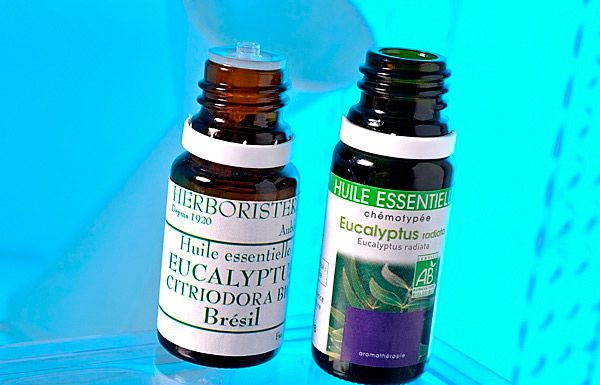
Eucalyptus leaves contain a small amount of essential compounds (up to 3%), which activate the discharge of phlegm and mucus, the same properties are inherent in essential oils of pine or spruce. Inhalations with mint oil, which works as a local antispasmodic, are also effective.
The following drugs are prescribed as mucolytics: ACC, ambrobene, ambroxol, lazolvan. If the cough is accompanied by the discharge of sputum containing pus, it is recommended to take antibacterial drugs of the cephalosporin group - cefazolin, cefamizin, suprax (granules for suspension or tablets). The most effective antimicrobial agents are those produced by the pharmaceutical industry in the form of aerosols for ENT irrigation - Givalex, Bioparox, Yoks. Treatment of acute tracheitis also includes the use of vitamin complexes in tablet form or in the form of intramuscular injections.
Warm drinks also help reduce the manifestation of the viral form of the disease, especially if it is a rosehip decoction that strengthens the immune system.
 [ 23 ]
[ 23 ]
How to treat chronic tracheitis?
The principles of therapy are identical to the treatment of acute tracheitis, however, unlike acute, the chronic form is often accompanied by the discharge of sputum with pus, which indicates the need to primarily carry out antibacterial treatment of tracheitis. The use of cephalosporin group drugs is indicated - cephalexin, cefazolin (first generation drugs). Antibacterial drugs in the form of aerosols and irrigation of the nasopharynx with chlorophyllipt are also effective.
If purulent sputum is secreted, broad-spectrum antibiotics, inhalations with drugs or products containing phytoncides are indicated - novocaine is mixed with onion or garlic juice in a 3/1 ratio. Chlorophyllipt is also an excellent phytoncide. Expectorants and herbal decoctions, abundant and frequent drinking are effective.
Reflex action drugs are prescribed as expectorants to activate the discharge of mucus and pus. Frequent and abundant drinking is recommended, preferably in the form of decoctions of medicinal herbs - chamomile, marshmallow root, coltsfoot, oregano. Decoctions should be used for quite a long time until stable remission occurs. The following plants are recommended as raw materials for herbal decoctions:
- nettle flowers - 1 tablespoon is poured with a glass of boiling water, infused for 20 minutes, drink half a glass twice a day;
- oregano - 1 teaspoon is poured with a glass of boiling water, infused for no more than 15 minutes, take a quarter of a glass three times a day;
- licorice root – 1 teaspoon of dry mixture is infused in a glass of boiling water for 20 minutes, drink a tablespoon 5-6 times a day;
- plantain leaves - 1 teaspoon is poured with a glass of boiling water and infused for 20 minutes, taken one tablespoon 4-5 times a day;
- a mixture of elderberry blossom, sage, licorice root and pine buds, taken 1 teaspoon each, is poured with a liter of boiling water, infused for 30 minutes, taken a quarter of a glass every two hours;
- a mixture of eucalyptus leaves, sage, chamomile, linden flowers, calendula flowers, taken 1 teaspoon each, poured with a liter of boiling water, infused for 10-15 minutes, taken a tablespoon every hour warm (store in a thermos).
Treatment of chronic tracheitis is characterized by a long period, sometimes taking several months, since the process affects not only the trachea, but most often the top of the bronchial tree.
 [ 24 ]
[ 24 ]
Treatment of tracheitis during pregnancy
Treating tracheitis during pregnancy is not an easy task, because many drugs, including herbal remedies, as well as warming procedures, are contraindicated for the expectant mother. In addition, the disease can be complicated by a bacterial infection, then you simply cannot do without antibiotics.
The first stage, which involves treating tracheitis in pregnant women, is determining the cause of the disease. If the disease is caused by a virus, then gentle immunomodulatory therapy, abundant alkaline drinking, bed rest and dosed inhalations will be enough. Warming up the feet and even mustard plasters for pregnant women pose a considerable threat. Rubbing the sternum should also be done as carefully as possible, mainly warming up the upper part of the sternum.
Treatment of tracheitis during pregnancy in case of bacterial infection involves taking relatively safe macrolides. Among the drugs that do not have a harmful effect on the condition of the pregnant woman and the fetus, one can name Sumamed or cephalosporin drugs. Any antibiotic is advisable to prescribe after the first trimester of pregnancy, when the mother's body has already adapted to the new condition, and many protective functions of the fetus are also strong. In the first trimester, the use of antibiotics can have an embryotoxic effect on the developing organs and systems of the baby.
Treatment of tracheitis during pregnancy is possible only under the supervision of a doctor; even if the disease is in a mild form, self-medication is unacceptable.
Treatment of tracheitis in children
Treatment of tracheitis in children should be as gentle as possible and, at the same time, comprehensive, since the very fact of the disease indicates a weakened immune system of the child. The disease in children is most often caused by viral infections, accordingly, the therapy should be antiviral. The main task that the treatment of tracheitis in children solves is to stop debilitating attacks of night cough. Then the issue of activating the protective properties of the body and detoxification is resolved, since the faster the virus is eliminated, the faster the effect of the treatment will come.
- Cough. Children are recommended to use antitussive syrups, which the pharmaceutical industry offers in sufficient quantities today. Of course, it is better if the doctor prescribes, since the cough can be of different nature - dry, with partial expectoration.
- Antiviral drugs for children, such as interferon, are indicated only if the viral infection becomes protracted.
- Antibiotics are prescribed in extreme cases of bacterial infection. Sumamed is effective, has no contraindications, and is available in a convenient form for children - as a suspension.
- Inhalations are effective – two or three times a day.
- To relieve inflammation in the larynx, trachea and bronchi, irrigation with Bioparox is prescribed.
- Treatment of tracheitis in children is impossible without plenty of warm drinks. This can be a decoction of expectorant herbs (it is more convenient to buy a ready-made chest collection), warm teas and vitamin fruit drinks.
- Rubbing the upper chest with Doctor MOM ointment and mustard plasters is effective, provided that the child does not have a fever.
Treatment of tracheitis in children usually lasts no more than two weeks if the disease is diagnosed in time and treated under medical supervision.
Effective treatment of tracheitis
Effective treatment of tracheitis consists of the following areas:
- General alarming symptoms are removed, usually cough. Medicines are prescribed that during the day ensure the transformation of unproductive dry cough into productive cough, at night, drugs are prescribed that suppress the cough reflex and reduce the frequency of coughing attacks.
- Neutralization of toxins and their removal from the body through drinking plenty of fluids.
- Anti-inflammatory therapy (antiviral).
- Antibacterial therapy.
- Antihistamine therapy for allergic etiology.
- Relief of complicated bronchospasms.
- Therapy that restores the structure of the tracheal mucosa.
- Immunomodulatory therapy that activates the body's defenses.
- Prevention
Effective treatment of tracheitis is always a complex of measures, including physiotherapy, inhalations, warming up, bed rest, and wet cleaning.

